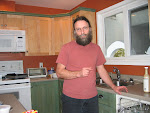We’re up at Mount Washington for our annual Between-Boxing-Day-and-New-Year’s-Eve ski holiday and today I decided to venture out cross-country skiing rather than go downhill. It’s been a few years now since I went Nordic. Once Lucas started skiing downhill, I joined in too. For a few years I pretended to be doing resort telemarking but I found I don’t really enjoy the groomed runs and longed for proper powder. So, it seemed best to simply go Alpine-style. It’s fun, for sure, but not a lot of exercise except for the occasions when I wander onto black diamond runs (much to Beth’s displeasure) and have to work very hard to get to the bottom (I don’t really know how to ski but I’m always up for an adventure!).
 This year I brought my cross country stuff with me (we bought a ski box for the car so there was lots of room for it) and today just seemed like a good day to go. I headed through the Alpine Village where we’re staying in the direction of Raven Lodge.It was a rude awakening to feel how shaky I was going down the hills just trying to get to the first trail. I knew my recent infrequent practice would have had an impact on my skill level (such as it ever was) and I knew before I set off that there was no way I could manage what used to be my favorite run here when we first came up here – taking the Hawk chair up to the top and going down the back “Upper West” trail. Still, it was a bit of a surprise to me to feel how little contact with the snow those tiny skis gave me as I (tried not to) zoom down hills.
This year I brought my cross country stuff with me (we bought a ski box for the car so there was lots of room for it) and today just seemed like a good day to go. I headed through the Alpine Village where we’re staying in the direction of Raven Lodge.It was a rude awakening to feel how shaky I was going down the hills just trying to get to the first trail. I knew my recent infrequent practice would have had an impact on my skill level (such as it ever was) and I knew before I set off that there was no way I could manage what used to be my favorite run here when we first came up here – taking the Hawk chair up to the top and going down the back “Upper West” trail. Still, it was a bit of a surprise to me to feel how little contact with the snow those tiny skis gave me as I (tried not to) zoom down hills. Once at Raven Lodge I did what I intended to do and set out on a moderate trail – “Paradise Meadow”, “Jack-Rabbit”, and “The Far East”, about a 10 k loop of moderate skiing. (Here's the map of the area -- 1.13 mb download though). I followed the trail in a clock-wise direction. I was the first person on the trail for the day (the only person I ran into during the first 45 minutes or so was the groomer who was just finishing off his work on the trail for me). After about 30 minutes that wonderful feeling overcame me: here I was in the middle of Strathcona Park, no one around, feeling fit and my gear in fine tune, just simply enjoying myself. Overall, it was a great run although I might do it in the opposite direction next time which seemed to be the more popular route, I noticed later, and then I’ll see if there’s less uphill going that way (just joking!).
I took a break at the Lodge for an hour or so, enjoyed a couple of cups of good coffee and a freshly baked muffin. Then I set out again. My confidence up, albeit knowing I was a bit tired, I set off on “Jutland” and then up the very aptly named “The Grind.” A two and one-half kilometer uphill, I tried hard to remember those instructions from my several seasons of skating lessons at the Canmore Nordic Centre – head up, alternate poling, use the legs not the arms – and eventually I made it – exhausted – up to “Lower West” which was a relief, at least in relative terms, and that took me back to the Alpine area.
Cross-country skiing attracts a varied group of people, including some older folks – older than me by a few years, certainly – who seems to maintain the classic style of skiing, even if their kick-and-glide tends to be more of the shuffle on most occasions (at least most of them don’t wear kickers and long socks anymore). I wonder what’s going to happen to those of us who see cross-country skiing as skating and not classic style – will we be able to maintain that cardiovascular output when we get to the age of those old-timers? I can’t ever see giving up my short skis and long poles, if only for those few moments of bliss that are produced when all systems seem to be flowing so well (and the terrain is flat!). I guess that’s another reason to make sure I use my time of leave profitably so I can maintain that needed level of fitness.
PS Update -- I went out again two days later. I discovered I had forgotten how to find ther edges on my skiis. After a bit, I remembered but not before I'd fallen and twisted myself in such a way as to make every stride thereafter painful. Still, I did survive "Lower West", "The Grind" and "Raven's Revenge" (in that order) and while I'm worn out and aching, it's good to know I can still do it!



